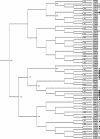Effect of condensed tannins on bacterial diversity and metabolic activity in the rat gastrointestinal tract
- PMID: 14766594
- PMCID: PMC348825
- DOI: 10.1128/AEM.70.2.1104-1115.2004
Effect of condensed tannins on bacterial diversity and metabolic activity in the rat gastrointestinal tract
Abstract
The effect of dietary condensed tannins (proanthocyanidins) on rat fecal bacterial populations was ascertained in order to determine whether the proportion on tannin-resistant bacteria increased and if there was a change in the predominant bacterial populations. After 3 weeks of tannin diets the proportion of tannin-resistant bacteria increased significantly (P < 0.05) from 0.3% +/- 5.5% to 25.3% +/- 8.3% with a 0.7% tannin diet and to 47.2% +/- 5.1% with a 2% tannin diet. The proportion of tannin-resistant bacteria returned to preexposure levels in the absence of dietary tannins. A shift in bacterial populations was confirmed by molecular fingerprinting of fecal bacterial populations by denaturing gradient gel electrophoresis (DGGE). Posttreatment samples were generally still distinguishable from controls after 3.5 weeks. Sequence analysis of DGGE bands and characterization of tannin-resistant isolates indicated that tannins selected for Enterobacteriaceae and Bacteroides species. Dot blot quantification confirmed that these gram-negative bacterial groups predominated in the presence of dietary tannins and that there was a corresponding decrease in the gram-positive Clostridium leptum group and other groups. Metabolic fingerprint patterns revealed that functional activities of culturable fecal bacteria were affected by the presence of tannins. Condensed tannins of Acacia angustissima altered fecal bacterial populations in the rat gastrointestinal tract, resulting in a shift in the predominant bacteria towards tannin-resistant gram-negative Enterobacteriaceae and Bacteroides species.
Figures






References
-
- Aiyar, A. 2000. The use of CLUSTAL W and CLUSTAL X for multiple sequence alignment. Methods Mol. Biol. 132:221-241. - PubMed
-
- Altschul, S. F., W. Gish, W. Miller, E. W. Myers, and D. J. Lipman. 1990. Basic local alignment search tool. J. Mol. Biol. 215:403-410. - PubMed
-
- Benoni, G., L. Cuzzolin, D. Zambreri, M. Donini, P. Del Soldato, and I. Caramazza. 1993. Gastrointestinal effects of single and repeated doses of ferrous sulphate in rats. Pharmacol. Res. 27:73-80. - PubMed
Publication types
MeSH terms
Substances
Associated data
- Actions
- Actions
- Actions
- Actions
LinkOut - more resources
Full Text Sources
Other Literature Sources
Molecular Biology Databases

